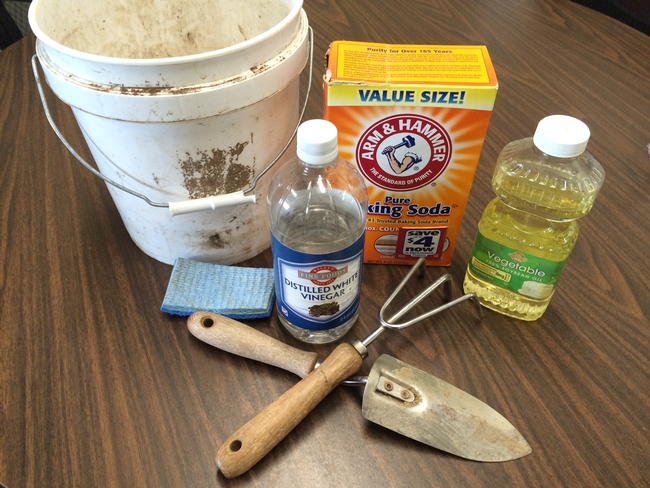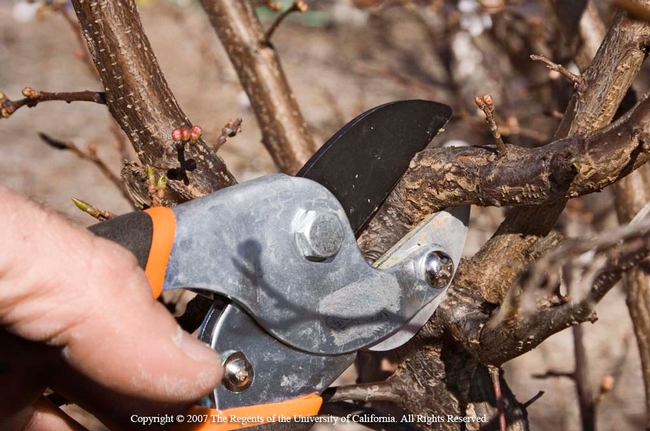Sadly, there are a lot of dull, rusted tools out there, even on productive farms. If you watch the videos at the end of this post, you will hear “Rust is always a sign of neglect” so let this be the end of neglect. Put your tools “to bed for the winter,” or prepare them for pruning season, right around the corner.
There are three main parts of tool maintenance: clean, sharpen, and lubricate. These three steps should simply be done, in that order, every single time a tool is put back in the shed. The more often you do it, the easier and more effective it is at improving the lifespan of your tools.
Clean: There are three steps - cleaning off debris, removing rust, and sanitizing to prevent the transfer of disease. Proper cleaning may require removing screws and partially dismantling the tool.
Clean – Pressurized water, or a wire brush and a little soapy water are effective when used to scrub off all dirt and debris from your tool.
Rust? – Sometimes, especially if your tools have not been constantly maintained properly, you may see a rusted tool that just isn't what it used to be. Don't worry, if you have this problem, there are some easy tips that can help take that rust off. Spray the tool with vinegar, wrap in a paper towel and cover in plastic for about three hours, up to 24 hours. Remove the paper towel and plastic. Use a brush, an old toothbrush works just fine on small projects, put some baking soda in water and use the brush to scrub off the rust. Turpentine and steel wool also work well. After you scrub the tool to remove the rust, rinse thoroughly with water.
Sanitize – To ensure your tools are not going to spread disease around your farm, sanitation is important. Wipe down the tool surface with a 10% bleach solution (10 parts water to 1 part bleach), leave it for 30 seconds and then rinse thoroughly with water. Be sure to dry and oil your tool after sanitizing to be sure it does not rust from the bleach! Learn how below.
Sharpen: Many tools, even though you may not think of them as having a blade, actually require frequent sharpening to ensure their consistent function. A shovel, for instance, needs sharpening on the edge, which helps cut through roots, make clean holes, among other things. The basic method of sharpening is pretty simple. Use caution when sharpening and be sure to wear the proper protective equipment, such as gloves and eye protection.
Stabilize – Small tools, such as hand pruning shears, may easily be held firmly with the non-dominant hand. Larger tools, such as mower blades, or loppers, may need to be held in a vise.
Sharpen - Locate the proper edges to sharpen. Remember that there is a cutting blade and a bypass edge on some tools like pruning shears. You only need to sharpen the blade. A file can be used and should only be pushed in one direction. Hold the file at an angle, usually 45 degrees to the blade. Be sure to lubricate the blade and properly tighten screws after sharpening.
If you would like to pay a professional to sharpen your tools, at our January 9th Farmer-to-Farmer Breakfast, Ruben with Sharpening Tech will available to sharpen tools. Watch for an announcement on the Foothill Farming Calendar.
Lubricate: It is very important to oil your tools, even if they do not need to be sharpened. Oil helps keep the rust at bay. If your tool comes in contact with food crops or soil, we recommend a plant-based oil, like linseed oil for wood handles, and vegetable oil for pruners and shovels. This should happen each time your tools are put away. A barrel or bucket with sand and a small amount of oil left near your tool shed will work. Simply stabbing the tool in and out of the sand mixture can remove debris and oil the tool at the same time.
Store your tools standing upright or hanging, this also helps prevent rust. Develop a system to maintain your tools and always have them in their correct place so that anyone working in your operation can find the right tool anytime. Livestock Advisor Dan Macon has developed a system of sharpening his tools and oiling all the handles on New Year's Eve each year. He also prepared a lambing box, and outfits it with sufficient supplies and freshly sharpened tools each year before lambing season. What systems do you use, or need to use, to be prepared in your operation?
Video Resources:
How to Easily Clean Rusted Gardening Tools – Organically! – Learn to use vinegar and baking soda to remove old rust from your hand tools. https://www.youtube.com/watch?v=jtdDotcHnl4
Sharpening Tools – Pruners, Loppers, Shovels and More! – GrowOrganic.com – Tips to properly clean, sharpen, and store your hand tools to improve their life and performance. https://www.youtube.com/watch?v=yn8npWqkCa8
How to Replace a Shovel Handle - Wranglerstar.com – A detailed, step by step demonstration on how to properly replace a broken shovel handle with a new one. https://www.youtube.com/watch?v=j5UH0Y4KurY

